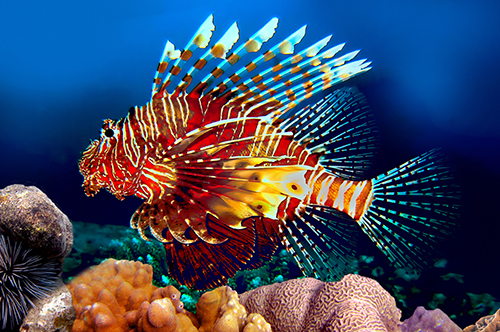
Pterois fish in the Atlantic range from 5 to 45 cm (2.0 to 17.7 in) in length, weighing from 0.025 to 1.3 kg (0.055 to 2.866 lb). They are well known for their ornate beauty, venomous spines, and unique tentacles. Juvenile lionfish have a unique tentacle located above their eye sockets that varies in phenotype between species. The evolution of this tentacle is suggested to serve to continually attract new prey; studies also suggest it plays a role in sexual selection.
Pterois species can live from 5 to 15 years and have complex courtship and mating behaviors. Females release two mucus-filled egg clusters frequently, which can contain as many as 15,000 eggs. Studies on Pterois reproductive habits have increased significantly in the past decade. All the species are aposematic: they have conspicuous coloration with boldly contrasting stripes and wide fans of projecting spines, advertising their ability to defend themselves.
According to a study that involved the dissection of over 1,400 lionfish stomachs from Bahamian to North Carolinian waters, Pterois fish prey mostly on small fish, invertebrates, and mollusks in large amounts, with some specimens’ stomachs containing up to six different species of prey. The amount of prey in lionfish stomachs over the course of the day suggests lionfish feed most actively from 7:00–11:00 am, with decreased feeding throughout the afternoon. Lionfish are skilled hunters, using specialized bilateral swim bladder muscles to provide exquisite control of location in the water column, allowing the fish to alter its center of gravity to better attack prey. The lionfish then spreads its large pectoral fins and swallows its prey in a single motion. They blow jets of water while approaching prey, apparently to disorient them.
History of Lionfish Migration (From USGS)

